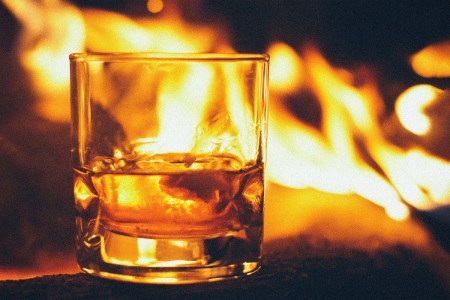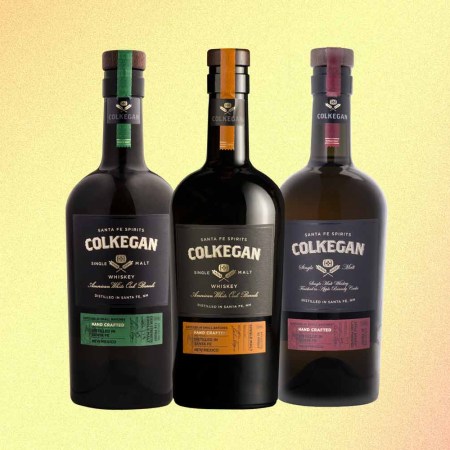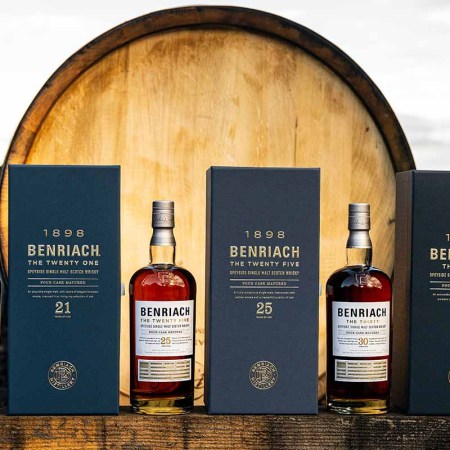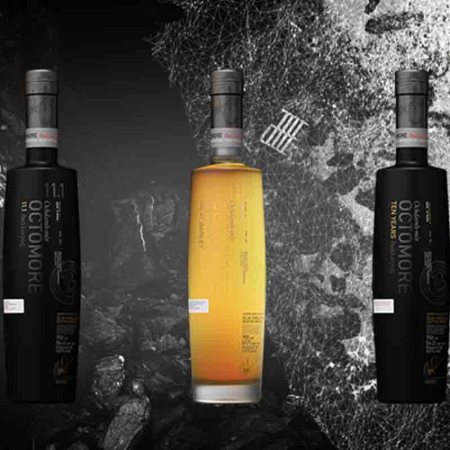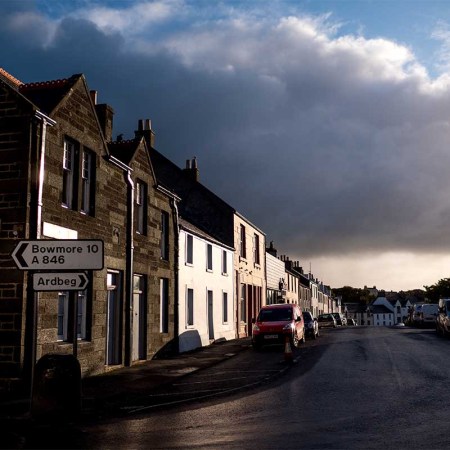In the whisk(e)y world, there are people who love a smoky dram and people who would rather drink turpentine. Of course, some land somewhere in-between, but this style tends to evoke strong feelings among brown spirits aficionados. Most smoky whisky (without the “e”) comes from Scotland, specifically the region of Islay where distilleries like Laphroaig, Lagavulin and Ardbeg are found.
It should be noted that, overall, peated whisky comprises just a small portion of the Scotch category — the majority of single malts are not smoky at all. And there is smoky whiskey being made in other parts of the world: Ireland has a few examples, as does Japan and India. Even here in America, you’ll find single malts being made in the Pacific Northwest using local peat and whiskey distilled in the Southwest from a mash bill of mesquite-smoked barley.
There is also a small but growing number of peated cask-finished whiskeys, a way of adding a bit of smoke without actually using peated barley in the mash bill. This type of secondary maturation is much less common than using sherry, rum or wine barrels to finish a whiskey, but there have been more expressions made using this technique over the past few years. And it’s not just whiskey — other spirits like tequila and rum have gotten this type of finish. Sometimes there is some corporate synergy involved, like if a drinks company happens to have an Islay distillery in its portfolio, making it easy to source those barrels and use them to finish another spirit that it owns.
Put Down the Peated Scotch and Pick Up a Smoky American Whiskey
How Whiskey Del Bac and other domestic distillers bring the fireAccording to Grant McCracken, CPO of Chattanooga Whiskey — which used peated casks from three different distilleries for its Triple Peat experimental release — this type of peated cask finish adds complexity. “Not only from their own house character and distillation process, but also from the peated malt that each distillery utilizes,” he says. “We tested bottling proof at 102, 110 and 118 to decide which one gave us the most complexity. Surprisingly, the lower proof whiskey gave too much smoke, and the high proof whiskey didn’t allow us to peel apart the smoke complexity — so we went with 111 proof.” McCracken said the distillery put some unpeated whiskey into these peated casks as well, but they lacked the depth he was looking for. “Layering the peat always seems like the best option for us,” he adds.
Manhattan’s Great Jones Distilling Co. released a peated cask-finished bourbon last year, and according to head distiller Celina Perez, the two styles blended harmoniously instead of overwhelming each other. “They retained their unique flavors while complementing one another, enhancing their distinctiveness in the finished blend — like two bulls you’d expect to clash but instead become friends,” she says. “The effects are both subtle and profound, starting with a robust, substantial character and finishing delicately, a balance that was certainly a surprise after nearly two years of maturation.”
If you’d like to try a peated cask-finished spirit for yourself, here’s a list of 10 whiskeys, tequilas and rums that spent some time in a peated cask, each sourced from a different distillery and subject to their own unique distillation and maturation process.

Chattanooga Whiskey Triple Peat
This whiskey from Tennessee craft distillery Chattanooga Whiskey was actually smoky before it went into peated casks for a secondary maturation. The whiskey is a blend of column- and pot-distilled bourbon and column-distilled malt whiskey made using three different peated malts in the mash bill that were imported from the UK. After initially aging in new charred oak, the whiskeys were finished in three different Islay scotch casks for nine to 24 months. That’s a complicated production and maturation process, but the result is a smoky whiskey with vanilla, caramel and oak notes from the bourbon that mingle with peat, honey and citrus from the peated malt and cask finish.

Great Jones Peated Scotch Cask
Great Jones is Manhattan’s first whiskey distillery since Prohibition, but while the team is distilling onsite, the whiskey you’ll find in bottles comes from the Black Dirt distillery upstate (Proximo Spirits own both). This distillery exclusive is a seven-year-old bourbon made from New York State grains, finished for a full two years in peated Scotch casks. If you visit the distillery, you can taste this expression on the VIP tour. Look for notes of honey, leather and an almost mesquite barbecue-like whiff of smoke floating on the back end of the palate.

Starward x Lagavulin
If you’re not familiar with Australian single malt, it’s time to change that. One of the leaders in the category is Starward, a Melbourne-based distillery that ages its whisky in red wine casks sourced from the region’s well-regarded wineries. A few months ago, Starward collaborated with Islay distillery Lagavulin (the latter is owned by Diageo, which invested heavily in the former) to release this single malt that spent 18 months finishing in peated casks. The whisky still has fresh red fruit notes picked up during its initial wine barrel maturation, along with a nice layer of smoke and iodine flavors on the back of the palate.

The Glenlivet Nadurra Peated Whisky Cask Finish
The Glenlivet is one of the most popular single malt Scotch brands in the world, and one that is not generally known for making peated whisky. But Nadurra is the exception to the rule — sort of. The distillery’s fruity single malt whisky is finished in barrels from an undisclosed distillery that previously held peated Scotch. This is a cask-strength whisky bottled at 61.5% ABV, so go ahead and add a few drops of water — it unlocks some of that smoky goodness on the palate.

Barrell Craft Spirits Tale of Two Islands
This whiskey is sort of stretching the concept of a peated cask finish, but stick with us here. The first Tale of Two Islands from Louisville blenders Barrell Craft Spirits was a Jamaican rum finished in peated casks from Islay. This second release uses those same casks to finish a blend of straight bourbon whiskeys from Indiana and Maryland to pick up sweet and smoky notes from the rum and initial peated cask finish.

El Tesoro Mundial Collection: Laphroaig
This is another case of corporate synergy at work. Both El Tesoro and Laphroaig are owned by parent company Suntory Global Spirits (formerly known as Beam Suntory), so it makes sense that this tequila would be finished in casks from that particular Islay distillery. This is an añejo expression that’s been aged for 12 months in Laphroaig 10-Year-Old Scotch Whisky barrels, adding some seaweed and soft savory smoke notes to the grassy, earthy, citrus-forward character of an already excellent tequila.

Don Julio Reposado Double Cask Finished in Lagavulin Casks
More corporate camaraderie is on display here, as drinks giant Diageo owns both Don Julio and Lagavulin. Don Julio followed up its Buchanan Scotch cask-finished tequila with this reposado, which spent 14 days in barrels used to mature some of the smokiest single malt to come from the island of Islay. This is a good tequila, and it seems like two weeks was enough time to impart the spirit with a light citrus and peated character, transforming it without overwhelming the agave character.

Balcones Prohibida Rum
Texas distillery Balcones kept things close to home for this peated cask-finished rum. The rum was distilled at the Waco distillery from 100% molasses, then aged in used barrels before being finished in casks previously used to mature Balcones’s own peated single malt. That whiskey was made from barley dried using a peat moss fire, giving it a sort of savory smokiness. That note transfers into this rum, which combines tropical fruit flavors with some campfire and smoked spiced apple notes.

Stiggins’ Fancy Smoky Formula Rum
This flavored rum comes from Planteray, which recently changed its name from Plantation Rum. This is a pineapple-infused rum that was aged in 200-liter barrels previously used to age Blackpitts, a peated Irish single malt whiskey from the Dublin distillery Teelings. While peated whiskey is relatively uncommon in Ireland, it’s certainly not unheard of. The addition of smoke to this fruity rum is a welcome one, imbuing it with a backbone that means it will transform any cocktail you make with it.

West Cork Glengarriff Peat Charred Cask
This Irish single malt was double-matured, first in sherry casks and then in peat-charred barrels for an additional four to six months. What that means is these barrels were not used to mature peated whiskey but were literally charred using peat to allow the wood to absorb the smokiness, which it then injected back into the whiskey.
Join America's Fastest Growing Spirits Newsletter THE SPILL. Unlock all the reviews, recipes and revelry — and get 15% off award-winning La Tierra de Acre Mezcal.

